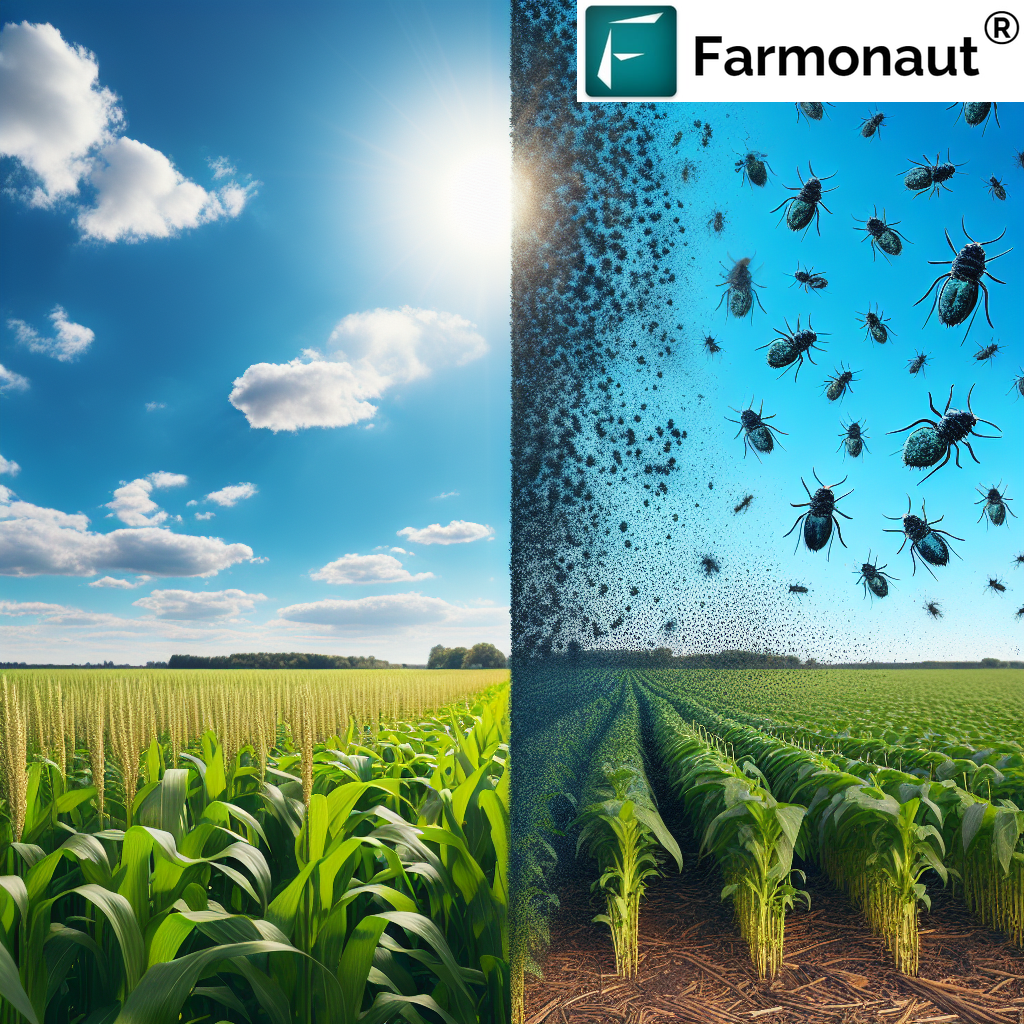Table of Contents
- Introduction
- The Science of Nitrogen in Plant Growth
- Coffee Grounds as a Nitrogen Source
- Comparative Nutrient Content Table
- Soil Benefits and Nutrient Availability from Coffee Grounds
- Modern Application Techniques: Coffee Grounds in Sustainable Agriculture
- Environmental and Economic Implications
- Limitations and Considerations of Coffee Grounds Use
- Farmonaut Satellite Solutions for Soil Health and Fertility Management
- Frequently Asked Questions (FAQ)
- Conclusion
- Farmonaut Subscriptions
Are Coffee Grounds a Good Source of Nitrogen for Plants? Understanding Their Role in Sustainable Farming (2025)
Are coffee grounds a good source of nitrogen for plants? This question has grown in importance in agricultural and horticultural circles, especially as we enter 2025—a year when sustainable soil fertility management and environmentally responsible farming are at the forefront of agro-innovation. Coffee grounds have long been recognized as an organic amendment with beneficial properties, but their potential as a source of nitrogen is often debated among growers, gardeners, and crop advisors worldwide.
The context of our times—marked by climate shifts, heightened food demand, and a pursuit of sustainable practices—demands a thorough understanding of how everyday waste materials can be repurposed to close nutrient loops and enhance crop productivity. This comprehensive exploration answers: “Are coffee grounds a good source of nitrogen for plants?” We’ll investigate the role of coffee grounds in soil nitrogen cycling, their benefits, application techniques, limitations, and their place in sustainable, tech-enabled agriculture in 2025.
The Science of Nitrogen in Plant Growth: Why Is It Essential?
Nitrogen is one of the most essential macro-nutrients a plant requires. Its presence is fundamental to processes such as photosynthesis, amino acid synthesis, and overall biomass development. Nitrogen forms the backbone of proteins, chlorophyll, and nucleic acids, directly influencing plant growth and crop productivity.
- Photosynthesis: Chlorophyll molecules rely on nitrogen to capture sunlight for energy conversion.
- Protein & Amino Acid Synthesis: Critical for growth, disease resistance, and yield.
- Biomass Development: Proper nitrogen levels mean vigorous roots, shoots, and fruiting bodies.
Soil nitrogen availability—naturally sourced or as a result of fertilizer application—is a decisive factor in global agricultural output. Historically, synthetic fertilizers have played a major role in meeting nitrogen demands, but their environmental impact (greenhouse gas emissions, leaching, and eutrophication risks) has driven research into organic and sustainable alternatives.
Coffee Grounds as a Nitrogen Source: Are Coffee Grounds a Good Source of Nitrogen for Plants?
Let’s examine the core question: Are coffee grounds a good source of nitrogen for plants? When we talk about coffee grounds, we refer to the residual product left after brewing coffee. This dark, crumbly material is classified in the “green” organic materials category due to its high nitrogen content (typically 2–3% by weight), similar to grass clippings.
How Coffee Grounds Deliver Nitrogen: The Role of Microbes & Decomposition
Coffee grounds do not deliver nitrogen to plants as quickly as mineral or synthetic fertilizers. Instead, their nitrogen release is mediated by microbial decomposition—a naturally occurring soil process where bacteria and fungi break down organic matter. During this process:
- The organic nitrogen in coffee grounds is gradually converted into forms (ammonium, nitrate) that plants can absorb.
- The rate of release is slower than with chemical fertilizers, but sustained, allowing for a more buffered, incremental nutrient supply.
This slow-release property makes coffee grounds an excellent soil enhancer for steady nutrient cycling, especially useful for sustainable agriculture and organic farming where rapid leaching is undesirable.
Coffee Grounds Composition: Not Just Nitrogen
Besides nitrogen, coffee grounds also provide:
- Potassium: Good for fruiting and overall crop health.
- Phosphorus: Supports root development and flowering.
- Micronutrients (magnesium, calcium, copper): Vital for various plant functions.
However, their most notable contribution is as a source of nitrogen for both soil microbial activity and plant growth, fostering healthy, productive soils.
Comparative Nutrient Content Table: Coffee Grounds vs Other Soil Amendments
To answer, “Are coffee grounds a good source of nitrogen for plants?” in context, compare them to other popular organic amendments. The following table provides estimated values for key nutrients, decomposition rates, and sustainability benefits—vital for making informed soil management decisions in 2025 and beyond.
| Soil Amendment | Estimated Nitrogen Content (% by weight) |
Other Key Nutrients | Decomposition Rate | Sustainability Benefits |
|---|---|---|---|---|
| Coffee Grounds | 2 – 3% | Small amounts of K, P, Mg, Ca, Cu | Medium (weeks to months, depending on conditions) | Reduces waste, boosts soil structure, moderate C:N ratio |
| Compost (well-rotted) | 1 – 2.5% | Balanced NPK, micronutrients | Medium-Fast (weeks in active piles) | Recycles organic waste, high microbial activity |
| Aged Manure (cattle) | 0.5 – 2% | P, K, organic matter | Medium (months for high benefit) | Reuses farm waste, enhances soil microbiome |
| Leaf Mulch | 0.5 – 1% | Trace amounts of Mg, Ca | Slow (months to over a year) | Reduces landfill waste, protects soil from erosion |
Soil Benefits and Nutrient Availability from Coffee Grounds
What practical benefits do coffee grounds offer to soil and how do they improve nutrient availability in both agricultural fields and home gardens?
1. Improving Soil Structure and Cation Exchange Capacity (CEC)
- Organic matter from coffee grounds boosts soil structure, increasing aeration and water retention.
- This increase in CEC means soils retain nutrients more effectively, reducing leaching—an advantage in areas with significant rainfall or irrigation.
2. Supporting Microbial Activity & Soil Health
- Coffee grounds act as food for beneficial microbes, supporting microbial activity vital for nutrient cycling and soil fertility.
- Research and extension services (notably from 2024) have shown that when coffee grounds are incorporated into compost piles, microbial activity accelerates, warming up the pile and breaking down organic matter more effectively.
3. Gradual Nitrogen Release: Readily Available and Slow Mineralization
- Coffee grounds deliver both readily available and slowly mineralizable nitrogen:
- Readily available nitrogen supports early growth stages.
- Slow-release nitrogen sustains crop nutrition over the growing season, matching plant uptake patterns in many systems.
4. Mulching and Soil Amendment Applications
- When applied correctly, coffee grounds improve upper-soil conditions as mulch: preserving moisture and reducing weed growth.
- In garden beds, flower pots, and fields, incremental application of coffee grounds contributes to an incremental increase in long-term nitrogen availability—supporting sustained nutrition for crops.
Modern Application Techniques: Maximizing the Benefits of Coffee Grounds in Sustainable Agriculture
To maximize the benefits of using coffee grounds for nitrogen supply in modern agriculture and gardening, precise application techniques and consideration of soil conditions are essential.
Incorporating Coffee Grounds into Compost Mixtures
- Balancing carbon-to-nitrogen ratios is critical to composting success; coffee grounds are a great “green” (nitrogen-rich) material to complement “brown” (carbon-rich) organic matter like dry leaves, straw, or wood chips.
- For optimal decomposition and odor control, keep the mix at about 1 part coffee grounds to 3–4 parts dry, carbonaceous material.
- According to research and extension services from 2024, this blend accelerates composting and produces a nutrient-rich final product with improved nutrient profiles.
Direct Soil Application & Mulching
- When applied as surface mulch, coffee grounds should be no more than 0.5–1 inch thick to avoid forming a water-repelling crust.
- Mixing coffee grounds lightly into the soil can enhance immediate nutrient availability and microbial activity, but application rates must remain moderate—typically no more than 20% by volume in garden beds.
- For sensitive crops (including certain vegetables) or soils prone to acidity, pair coffee grounds with lime or mix with mature compost to buffer pH changes.
Integrating into Biofertilizer & Fertilizer Blends in Modern Farming Systems
- Large-scale farming operations, especially those using precision agriculture systems in 2025, increasingly blend processed coffee grounds into organic fertilizer and biofertilizer formulations for controlled, gradual nitrogen release.
- This integrated management approach reduces reliance on synthetic fertilizers—offering both environmental and economic benefits.
For those interested in satellite-based precision agriculture tools for monitoring soil conditions, nitrogen status, and amendment effectiveness, Farmonaut’s comprehensive products are invaluable. For instance, the  Monitor crops, analyze soil and resource efficiency with Farmonaut’s web and mobile apps—helping optimize organic amendment strategies in real time.
Monitor crops, analyze soil and resource efficiency with Farmonaut’s web and mobile apps—helping optimize organic amendment strategies in real time.
Environmental and Economic Implications: Coffee Grounds as a Sustainable Resource
Repurposing coffee grounds as a soil nitrogen source advances sustainable practices and aligns with circular economy principles central to agriculture in 2025.
- Reducing landfill waste: Global coffee consumption produces more than 6 million tons of spent grounds yearly. Reclaiming this organic material as a soil amendment diverts it from landfill, reducing methane emissions.
- Lowering environmental risks: Using organic nitrogen sourced from waste streams (like coffee grounds) lessens dependency on energy-intensive synthetic fertilizers and limits associated greenhouse gas emissions, nitrate leaching, and pollution.
- Fostering biodiversity and soil health: Composting and field application of coffee grounds encourage healthy soil microbial cycles, supporting long-term soil fertility, crop resilience, and overall sustainability.
- Economic savings: For city farms, community gardens, and even commercial growers, sourcing used coffee grounds can be a cost-effective alternative or supplement to purchased fertilizers, especially in regions with abundant coffee vendors.
Farmonaut makes it simpler to track the environmental impact of your organic waste recycling decisions in farming. Using our Carbon Footprinting platform, farmers can measure and reduce their agricultural emissions when substituting synthetic fertilizers with coffee grounds and other organic amendments. Our satellite-based insights help you:
- Quantify emission reductions from organic waste recycling
- Monitor soil health changes in near real time
- Optimize field management decisions for environmental stewardship
Limitations and Considerations: Potential Risks in Coffee Grounds Application
Despite their benefits, coffee grounds are not without potential drawbacks. Consider these limitations before large-scale or repeated use:
- Acidity and Soil pH: Uncomposted coffee grounds are slightly acidic (pH 5.5–6.8). While this can help neutral or alkaline soils, over-application, especially in soils already acidic, can temporarily depress pH and inhibit the growth of pH-sensitive plants—such as beans, brassicas, and certain vegetables.
- Allelopathic Potential: Fresh coffee grounds may contain caffeine and other organic acids which, in high concentrations, have been linked to inhibited seed germination and root development in some crops.
- Inconsistent Nutrient Release: Factors such as temperature, microbial diversity, and moisture affect decomposition and nutrient availability. This means results can vary, making soil testing important.
- Not a Complete Fertilizer: While coffee grounds are a valuable source of nitrogen, they do not replace the role of complete fertilizers in intensive or high-demand cropping systems (e.g., cereals, commercial vegetables). Complementary fertilizers (organic or mineral) remain necessary for balanced nutrition.
Best Practices:
- Compost coffee grounds before field application to stabilize pH and caffeine content.
- Conduct soil tests and consult with a soil health adviser (or use satellite-based monitoring systems like Farmonaut Crop, Plantation & Forest Advisory Solutions) to tailor amendment rates.
- Rotate with other organic amendments—like compost or manure—to balance nutrient cycles and soil health.
Farmonaut Satellite Solutions for Soil Health and Fertility Management
Farmonaut (as a satellite technology company) enables next-generation soil fertility management and sustainable nutrient cycling. Our platform empowers:
- Real-time soil condition monitoring—using multispectral satellite imagery to track soil organic matter, moisture, and nutrient status across expansive fields or specific areas of interest.
- Precision management of organic amendments—with AI-based advisory systems (Jeevn AI) analyzing satellite data to suggest optimal application windows and rates for coffee grounds and other soil enhancers.
- Blockchain-enabled traceability—for credible documentation of sustainable practices, compliance, and added market value.
- Fleet and resource management tools—helping farm managers optimize machinery use during compost and amendment spreading operations, minimizing cost and fuel use.
Learn about Farmonaut Fleet Management for logistics optimization. - Environmental impact tracking—monitoring field-level carbon footprint (via Farmonaut’s carbon tracking tools), reinforcing data-driven stewardship.
- Large-scale farm management: For agribusinesses aiming to upgrade soil health at scale, our Large Scale Farm Management platform delivers comprehensive dashboards, multi-field monitoring, and integration with amendment schedules.
Our solutions are available through intuitive web and mobile applications, with dedicated apps for Android ( ) and iOS (
) and iOS ( ). For enterprise-level integration, explore our APIs and developer documentation (Read API Docs).
). For enterprise-level integration, explore our APIs and developer documentation (Read API Docs).
Frequently Asked Questions (FAQ)
Are coffee grounds a good source of nitrogen for plants compared to synthetic fertilizers?
Yes, coffee grounds are a beneficial source of organic nitrogen, offering a slow-release nutrient supply and supporting soil health. However, they do not deliver nitrogen as rapidly or in as concentrated a form as synthetic fertilizers, so for high-demand crops, complementary fertilization is needed.
How much coffee grounds should I apply to my soil?
Apply moderately—no more than 20% of the total soil or compost mix, or as a thin mulch no thicker than 1 inch. Excessive application may make soil too acidic or inhibit certain plant growth due to caffeine residues.
Can farm-scale operators replace all nitrogen fertilizers with coffee grounds?
No. While useful as part of a sustainable nutrient management program, coffee grounds alone cannot meet the nitrogen needs of intensive, high-yield agricultural systems. They should be used alongside other organic amendments and (if needed) mineral fertilizers, guided by soil testing and monitoring.
How do I process coffee grounds for best use in farming?
Compost coffee grounds with carbon-rich materials to buffer acidity, eliminate allelopathic substances, and stabilize nutrients. Well-rotted compost containing coffee grounds is safe and beneficial for nearly all crops and soils.
Does using coffee grounds in fields or gardens harm the environment?
When used properly, they offer environmental benefits—reducing landfill waste and decreasing reliance on synthetic inputs. Always use in moderation and in context of local soil conditions for best sustainability outcomes.
Conclusion: Coffee Grounds as a Sustainable Nitrogen Source in 2025 and Beyond
Are coffee grounds a good source of nitrogen for plants? Absolutely—when used as part of an integrated soil fertility management plan. Their slow release of nitrogen, enhancement of soil structure, and contribution to sustainable nutrient cycling make them a valuable organic resource in modern agriculture and gardening. As we move further into the 2025 era of environmental stewardship, coffee grounds, properly processed and wisely applied, will play a real role in enhancing crop productivity, reducing waste, and advancing sustainable farming practices worldwide.
Leverage satellite technology and real-time soil monitoring for best results—Farmonaut apps and platforms are designed to support sustainable agriculture, optimize organic amendment strategies, and deliver actionable insights for smarter, greener farming and gardening choices.
Farmonaut Subscriptions: Join the Future of Sustainable Agriculture
Ready to revolutionize your approach to soil health, resource management, and sustainable farming? Explore Farmonaut’s scalable subscription options—designed for individual users, agribusinesses, and government institutions. Flexible plans, advanced dashboards, and integrated analytics help you unlock value from your organic amendment strategies in 2025 and beyond.
Looking for advanced, real-time, and scalable soil monitoring solutions? Discover Farmonaut’s complete platform for precision agriculture, sustainable farming, and environmental stewardship.









